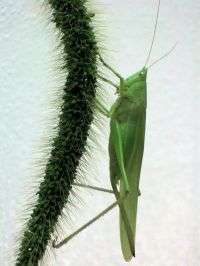Female katydids prefer mates 'cool' in winter and 'hot' in summer

Katydid (or didn’t she?) respond to the mating call of her suitors. According to scientists at the University of Missouri, one species of katydid may owe its ecological success and expanded habitat range to the ability of male katydids to adjust their mating calls to attract females.
Males of the katydid species Neoconocephalus triops, which can be found from Peru to Missouri, produce calls to attract females for mating that change with the seasons. The males’ summer calls are much faster than their winter calls. Johannes Schul, MU associate professor of biological sciences, found that females were attracted only by a specific speed of the calls and this preference changed with temperature.
“Warm females preferred much faster calls than cold females,” Schul said. “The fast summer calls attracted females only at high temperatures and the slow winter calls only at lower temperatures. Thus, during the winter, females prefer ‘cool guys,’ and in the summer they ‘like them hot.’ ”
According to Schul, male calls exhibit substantial flexibility. At equal temperatures, summer males, or those that mature during the summer, produce calls with a higher pulse rate than winter males, or those that mature in late winter/early spring. The research team tested the katydids’ preferences by placing females on a spherical “treadmill” and tracking the speed and accuracy of their responses to recordings of male calls.
“The really amazing thing about the katydids is that these specific calls are what keeps them from mating with the wrong species,” Schul said. “It’s amazing how these calls can be flexible, but still work to maintain their specificity.”
In the study, females had strong preferences for pulse rates within a narrow range. The attractive ranges did not differ between summer and winter females. Both male pulse rate of calls and female preference for pulse rate changed with ambient temperature. Female preference changed more than male calls. The summer call was only attractive at 25 degrees Celsius (77 degrees Fahrenheit), whereas the slower winter call was only attractive at 20 degrees Celsius (68 degrees Fahrenheit).
Schul said further studies, conducted with graduate student Oliver Beckers in the MU College of Arts and Science, may help determine if females ‘force’ males to use two different calls or whether males having two different calls actually ‘force’ females to adjust their preferences.
Source: University of Missouri-Columbia















